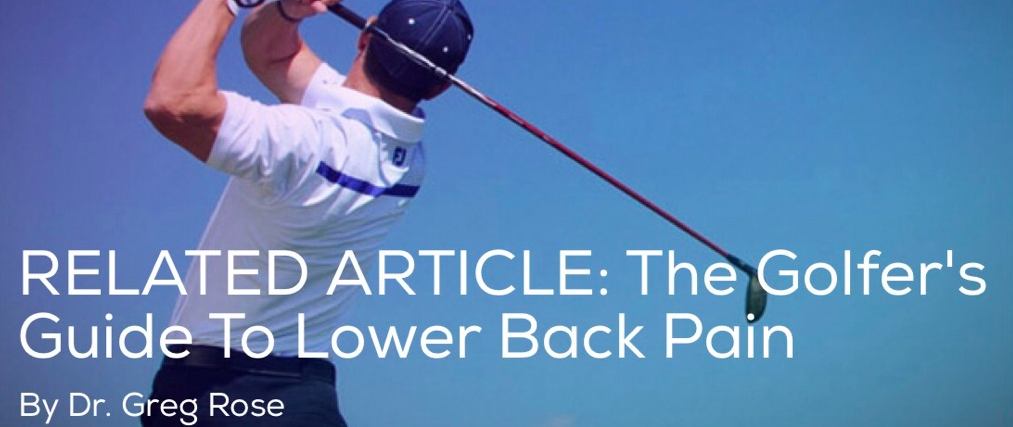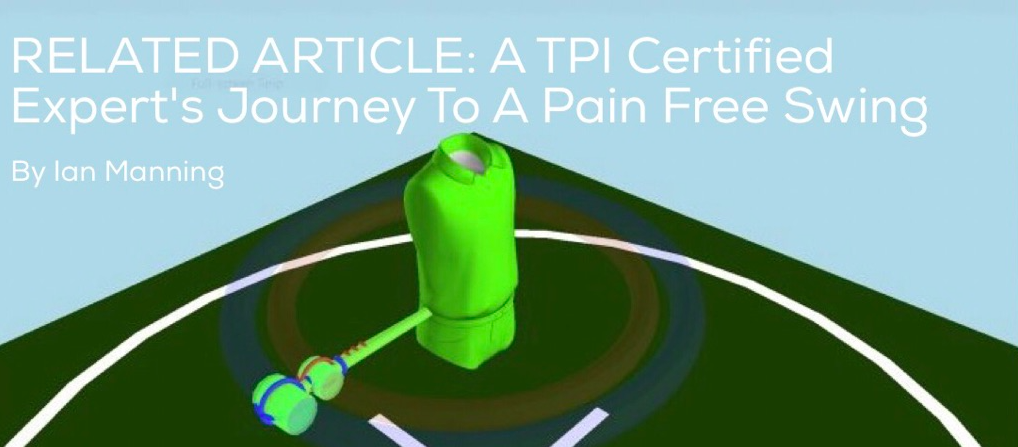IMPROVE MY GAME
Articles
Back to Golf: Important Considerations for Golfers Undergoing Rehab Following Back Surgery
Fri Apr 21, 2017 by Dr. Paul Houle and Catherine Hoell

In my previous article (“When Surgery is the right Treatment for Your Herniated Disc”), I discussed surgical treatment options for herniated discs in the low back and their relationship to muscle imbalances that are often responsible for swings characteristics.
While I practice as a neurosurgeon, specializing in minimally invasive spinal procedures, I only recommend surgery as a last resort. As I mentioned in the first article, studies have shown that conservative therapy is an effective technique to recover from issues like herniated discs. However, if all other strategies are ineffective, surgery may be the most appropriate option.
It is important to understand that surgery is just the first step, a giant leap if you will, on the road to recovery. I explain to my patients that surgery sets the stage, but rehab and exercise gets you back to normal.
Just yesterday (April 20th), the most famous golfer on the planet announced that he had successfully undergone his fourth back operation in three years. I won't comment on Tiger's condition specifically, but the general principles of this rehab could be followed for his procedure (minimally invasive Anterior Lumbar Interbody Fusion).
Depending on the type of surgery, key muscles may have been destroyed and require time to heal and return to normal function. Much of the muscle dysfunction that can occur following surgery is caused by denervation of the muscle. What this means is that the nerves that supply your back muscles are damaged as part of the surgical procedure and these nerves must regenerate and contact those muscles before your muscles can become strong. This process can take many months. This is why it takes such a long time to return to play. Weak back muscles coupled with shortened hip flexors leads to hip immobility and puts you at risk to re-injure your back. Furthermore, complex movements such as a golf swing require the nerves to fire in a coordinated sequence to properly deliver the clubface squarely to the ball.
Typically, a golf-specific rehab program will begin one to three weeks after surgery. My team and I believe that there are three phases to the golf rehab program and each phase builds on the next to promote the patient back to golf at the highest level of function with the least amount of pain. This comprehensive post-surgical rehab program is unique because after the surgeon removes the pressure from the nerve, a physical therapist who specializes in golf is able to evaluate functional movement early in the recovery phase, and prescribe customized exercises and correct dysfunctional synergy patterns affecting the lumbar spine. This team approach maximizes the golfer’s body performance while ensuring proper lumbar protection.
Here is how my team organizes the phases for golf-specific rehab:
-
PHASE 1: PROTECTIVE TISSUE HEALING/NEUTRAL SPINE
-
PHASE 2: CORE STABILIZATION, ENDURANCE AND FLEXIBILITY
-
PHASE 3: GOLF KINEMATIC CONDITIONING/DYNAMIC STABILIZATION
The rehab process will usually consist of around 8-12 physical therapy visits and usually is completed by the third postoperative month. Most patients require a minimum of 12 weeks of rehabilitation before safely returning to golf. Obviously, some procedures/patients merit a longer rehab program.
The most important aspect is that the time period allows for the proper strength needed for spinal stabilization to meet the demands of the golf swing. The program must be adjusted to meet the unique needs of each golfer. Additionally, physical assessment findings (TPI, FMS, SFMA, etc) and goals of the golfer are considered when prescribing the exercises. The exercises can be modified, decreased or discontinued based on the patient’s symptoms and pain. Factors such as age, level of conditioning, extent of surgery, radiographic criteria, patient’s lifestyle, and the patient’s desire to return to golf are considered for each phase progression.
PHASE 1: The goal of Phase 1 is to promote tissue healing, establish early pain free mobility, and begin core stabilization. Proper form for all exercises are reinforced throughout the program. Once patients have mastered pain free and proper form with the Phase 1 exercises, patients progress to Phase 2 which builds upon Phase 1 exercises and incorporates dynamic strength components specific to the golf swing. Exercises in this phase are typically done 2x/day, 3-4 x/week. Below are an example of appropriate Phase 1 exercises.
- Deer in headlights – Click Here
- Pelvic Tilts – Click Here
- Dead Bugs – Click Here
- Bridge – Click Here
- Bird Dog- Click Here
- Hamstring – Click Here
- Cats & Dogs – Click Here
- Calf Stretch – Click Here
PHASE 2: Goals in this phase focus on continuation of core strength building, correcting dysfunctional movement patterns, and normalizing spinal range of motion and flexibility. This phase is critical, to ensure early detection and correction of the golfer’s previous movement patterns that may have contributed to excess spinal compression and degenerative disease. Patients are reassessed at constant intervals during this phase by the physical therapist using the SFMA (Selected Functional Movement screens) and other evaluative measures. Exercises in this phase are to be done 1x/day, 3-4 x/week, stretching every day. Once patients have demonstrated good tissue healing, proper synergy movement patterns, pain-free spine ROM, and have mastered phase 2 exercises, they are promoted to Phase 3. Below are an example of appropriate Phase 2 exercises.
- Dead Bugs 2 – Click Here
- Open Books – Click Here
- Standing Prayer – Click Here
- Active Leg – Click Here
- Deep Squat – Click Here
- Hip Drops – Click Here
- Clam Shells- Click Here
- Cable Row – Click Here
PHASE 3: The goals in this phase are to maximize core strength needed for golf, as well as progress balance and proprioception to maximize spine protection during the golf swing. These exercises focus on golf-specific flexibility, dynamic core stabilization, proprioception, and balance are progressed to maximize power and accuracy. Exercises in this phase are to be done 1x/day 3-4x/week, stretching to be done daily. Below are an example of appropriate Phase 3 exercises.
- Planks – Click Here
- Chop – Click Here
- Walks – Click Here
- Box Squats – Click Here
- Hip Turns – Click Here
- Lunges – Click Here
- Torso Backswing – Click Here
At this stage, it is my recommendation that patients wishing to return to golf undergo a TPI screening by a TPI Certified professional. If the patient experiences any pain during any of the physical assessment screenings, then they are not ready to swing a club and should continue the rehabilitation process focusing on the TPI screening failures. This process should be repeated in approximately 8 weeks. If there is no pain, then it is safe to swing a club. I would recommend TPI screens be performed regularly to identify any weakness that could occur that would predispose the golfer to further back injury.
Patients are discharged after they have completed all phases of the rehab program and their individual physical therapy goals have been achieved. The physical therapist is responsible for patient discharge when appropriate. Upon discharge, patients are expected to continue their prescribed home program for golf to reduce risk of injury. Please ask your physical therapist which program may be right for you.
About your golf medical team:
Dr. Paul Houle is a neurosurgeon specializing in minimally invasive spinal procedures. He received his medical degree from Boston University School of Medicine in Boston, and completed his residency in neurosurgery at the University of Georgia. He is the Chief of Neurosurgery at Cape Cod Healthcare (find them on Facebook). Dr. Houle attended TPI Level 1 in 2016 and is TPI Certified.
Catherine Hoell PT, DPT, OCS, is a physical therapist specializing in orthopedics and golf rehabilitation. She received her doctorate degree from Massachusetts General Hospital Institute of Health Professions in Boston, and is board certified in Orthopedics. Dr. Hoell is a lead physical therapist at Cape Cod Healthcare and is TPI certified Medical Level 3.
References:
- Abla, A et al. Return to golf after spine surgery. J Nerosurg Spine 14:23-30, 2011.
- Marras, W et al. Spine loading characteristics of patients with low back pain compared with asymptomatic individuals. Spine, Vol 26, Number 23, pp 2566-2574, 2001.
- Gluck, G et al. The lumbar spine and low back pain in golf: a literature review of swing biomechanics and injury prevention. Spine, Vol 8, pp 778-788, 2008.
- Hides, J. Multifidous muscle recovery is not automatic after resolution of acute, first-episode low back pain. Spine, Vol 21(23) pp 2763-2769, 1 December 1996.
- Yung-Shen Tsai et al. A comparison of physical characteristics and swing mechanics between golfers with and without a history of low back pain. Journal of Orthopedics and Sports Physical Therapy, Vol 40, Number 7, pp 430-438, July 2010.
- Richardson, C et al. The relationship between the transverse abdominis muscles, sacroiliac joint mechanics, and low back pain. Spine, Vol 27, Number 4, pp 399-405, 2002.
** Rehab protocol developed by
Catherine Hoell, PT, DPT, OCS
Lead Clinical Specialist Oppenheim Medical Building
p 508-348-5010


